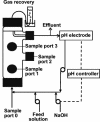Desulfitobacterium hafniense is present in a high proportion within the biofilms of a high-performance pentachlorophenol-degrading, methanogenic fixed-film reactor
- PMID: 15691966
- PMCID: PMC546785
- DOI: 10.1128/AEM.71.2.1058-1065.2005
Desulfitobacterium hafniense is present in a high proportion within the biofilms of a high-performance pentachlorophenol-degrading, methanogenic fixed-film reactor
Abstract
We developed a pentachlorophenol (PCP)-degrading, methanogenic fixed-film reactor by using broken granular sludge from an upflow anaerobic sludge blanket reactor. This methanogenic consortium was acclimated with increasing concentrations of PCP. After 225 days of acclimation, the reactor was performing at a high level, with a PCP removal rate of 1,173 muM day(-1), a PCP removal efficiency of up to 99%, a degradation efficiency of approximately 60%, and 3-chlorophenol as the main chlorophenol residual intermediate. Analyses by PCR-denaturing gradient gel electrophoresis (DGGE) showed that Bacteria and Archaea in the reactor stabilized in the biofilms after 56 days of operation. Important modifications in the profiles of Bacteria between the original granular sludge and the reactor occurred, as less than one-third of the sludge DGGE bands were still present in the reactor. Fluorescence in situ hybridization experiments with probes for Archaea or Bacteria revealed that the biofilms were composed mostly of Bacteria, which accounted for 70% of the cells. With PCR species-specific primers, the presence of the halorespiring bacterium Desulfitobacterium hafniense in the biofilm was detected very early during the reactor acclimation period. D. hafniense cells were scattered in the biofilm and accounted for 19% of the community. These results suggest that the presence of PCP-dehalogenating D. hafniense in the biofilm was crucial for the performance of the reactor.
Figures




Similar articles
-
The pentachlorophenol-dehalogenating Desulfitobacterium hafniense strain PCP-1.Philos Trans R Soc Lond B Biol Sci. 2013 Mar 11;368(1616):20120319. doi: 10.1098/rstb.2012.0319. Print 2013 Apr 19. Philos Trans R Soc Lond B Biol Sci. 2013. PMID: 23479749 Free PMC article. Review.
-
Microstructure of anaerobic granules bioaugmented with Desulfitobacterium frappieri PCP-1.Appl Environ Microbiol. 2002 Aug;68(8):4035-43. doi: 10.1128/AEM.68.8.4035-4043.2002. Appl Environ Microbiol. 2002. PMID: 12147505 Free PMC article.
-
Strategies for augmenting the pentachlorophenol degradation potential of UASB anaerobic granules.Water Sci Technol. 2002;45(10):35-41. Water Sci Technol. 2002. PMID: 12188570
-
Performance of a horizontal-flow anaerobic immobilized biomass (HAIB) reactor and dynamics of the microbial community during degradation of pentachlorophenol (PCP).Anaerobe. 2008 Nov;14(5):268-74. doi: 10.1016/j.anaerobe.2008.09.004. Epub 2008 Oct 17. Anaerobe. 2008. PMID: 18992351
-
Upflow anaerobic sludge blanket reactor--a review.Indian J Environ Health. 2001 Apr;43(2):1-82. Indian J Environ Health. 2001. PMID: 12397675 Review.
Cited by
-
Lack of electricity production by Pelobacter carbinolicus indicates that the capacity for Fe(III) oxide reduction does not necessarily confer electron transfer ability to fuel cell anodes.Appl Environ Microbiol. 2007 Aug;73(16):5347-53. doi: 10.1128/AEM.00804-07. Epub 2007 Jun 15. Appl Environ Microbiol. 2007. PMID: 17574993 Free PMC article.
-
Dynamic transition of a methanogenic population in response to the concentration of volatile fatty acids in a thermophilic anaerobic digester.Appl Environ Microbiol. 2006 Feb;72(2):1623-30. doi: 10.1128/AEM.72.2.1623-1630.2006. Appl Environ Microbiol. 2006. PMID: 16461718 Free PMC article.
-
Genome sequence of Desulfitobacterium hafniense DCB-2, a Gram-positive anaerobe capable of dehalogenation and metal reduction.BMC Microbiol. 2012 Feb 8;12:21. doi: 10.1186/1471-2180-12-21. BMC Microbiol. 2012. PMID: 22316246 Free PMC article.
-
The pentachlorophenol-dehalogenating Desulfitobacterium hafniense strain PCP-1.Philos Trans R Soc Lond B Biol Sci. 2013 Mar 11;368(1616):20120319. doi: 10.1098/rstb.2012.0319. Print 2013 Apr 19. Philos Trans R Soc Lond B Biol Sci. 2013. PMID: 23479749 Free PMC article. Review.
-
Microeukaryote diversity in a marine methanol-fed fluidized denitrification system.Microb Ecol. 2008 Nov;56(4):637-48. doi: 10.1007/s00248-008-9383-x. Epub 2008 May 9. Microb Ecol. 2008. PMID: 18465167
References
-
- Ahring, B. K., N. Christiansen, I. Mathrani, H. V. Hendriksen, A. J. L. Macario, and E. C. de Macario. 1992. Introduction of a de novo bioremediation ability, aryl reductive dechlorination, into anaerobic granular sludge by inoculation of sludge with Desulfomonile tiedjei. Appl. Environ. Microbiol. 58:3677-3682. - PMC - PubMed
-
- Angelidaki, I., L. Ellegaard, and B. K. Ahring. 2003. Applications of the anaerobic digestion process. Adv. Biochem. Eng. Biotechnol. 82:1-33. - PubMed
-
- Araujo, J. C., G. Brucha, J. R. Campos, and R. F. Vazoller. 2000. Monitoring the development of anaerobic biofilms using fluorescent in situ hybridization and confocal laser scanning microscopy. Water Sci. Technol. 41(12):69-77.
Publication types
MeSH terms
Substances
LinkOut - more resources
Full Text Sources

